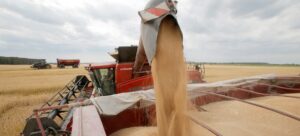
The export of Ukrainian agricultural products through the EU countries, taking into account deliveries through the Danube river ports, cannot exceed 1.5 million tonnes per month under any circumstances, while before the blockade of its seaports by the Russian troops, the country could monthly transship over 5 million tonnes of agricultural crops per month.
An opinion about a need for Ukraine to work on the launch of new logistics routes and export directions was expressed by First Deputy Minister of Agrarian Policy and Food Taras Vysotsky during the expert discussion “Blocked trade: can Ukraine increase export capacity” on Friday.
“We preliminary calculated that up to 1.5 million tonnes are still the maximum. Therefore, I think that we can count on this until May, and then only alternative directions,” Vysotsky said.
He clarified that Ukraine has enough agricultural products for export, and Ukrainian farmers can supply as much grain as they need to foreign markets, and the volume of its exports is limited only by logistics.
As reported with reference to Minister of Agrarian Policy Mykola Solsky, in April 2022 Ukraine exported 1.09 million tonnes of grain mainly through Romanian ports, which is more than five times higher than in March.
According to him, most of the export deliveries from Ukraine were carried out in April through the Danube river ports, since the Ukrainian Black Sea ports are blocked by Russian warships.
At the same time, the logistics of Ukrainian agricultural products through Romania may become more complicated and slow down in June, when a new crop of Romanian, Serbian, Hungarian and Bulgarian winter wheat and barley will begin to arrive at the seaports of this country and will create competition with supplies from Ukraine.

Since the beginning of the 2021/2022 marketing year (MY, July-June) and as of May 5, Ukraine has exported 46.0 million tons of grain and leguminous crops, which is 17.9% or 7.0 million tons higher than on the same date of the previous MY.
According to the Information and Analytical Portal of the Agroindustrial Complex of Ukraine, by May 5, 18.53 million tons of wheat were exported (22.5% more compared to the same date in 2020/2021MY), 21.33 million tons of corn (+11.4%), 5.68 million tons of barley (+37.8%) and 69.7 thousand tons of flour (-34.4%).
161.9 thousand tons of rye were also delivered to foreign markets against only 1.7 thousand tons a year earlier.
Thus, for the week of April 28 – May 5, Ukraine exported about 300 thousand tons of grain crops, including almost 270 thousand tons of corn, 20 thousand tons of wheat and 10 thousand tons of barley. Such a decline is explained by the blockade by the troops of the aggressor country of the Russian Federation of Ukrainian seaports – its key export infrastructure.
As reported, in 2020/2021, Ukraine exported 44.72 million tons of grain and leguminous crops, including 16.64 million tons of wheat, 23.08 million tons of corn, 4.23 million tons of barley. Also, 126.9 thousand tons of flour and 18.4 thousand tons of rye were delivered to foreign markets.
In addition, Ukraine exported 56.72 million tons of grain and leguminous crops in 2019/2020 MY.
Deputy Head of the Office of the President Rostyslav Shurma in March called the goal of Ukraine in 2022 to harvest at least 70% of last year’s crop.

Analysts at Alfa-Bank Ukraine expect a reduction in the grain harvest in 2022 to 56 million tons, which will be the lowest figure in the last 10 years and will mean a decrease of 34% to a record figure for 2021.
“Even this historically small harvest will provide a significant resource of grain for export. Now available transport channels do not make it possible to ship such volumes of marketable products abroad,” commented the head of the analytical department Alexei Blinov in the bank’s report.
It is indicated that the assessment of the future harvest is based on calculations of the sown area in the zone of occupation or active hostilities, as well as the current dynamics of the sown area in the territories controlled by Ukraine. Analysts at Alfa-Bank Ukraine also expect some reduction in yields due to lack of fertilizers and plant protection products.
“The key to Ukraine’s agricultural exports, and this is the food security of the world, should be the lifting of the blockade of Ukrainian seaports,” Blinov stressed.

Romania has announced a tender for the repair of a broad-gauge railway connecting its Danube river port of Galati and the Moldovan river port of Giurgiulesti in order to transport grain from Ukraine without changing the rolling stock, since exports from Ukrainian seaports are blocked by warships of the aggressor country of the Russian Federation.
On the relevant statement of the Minister of Transport of Romania, Sorin Grindeanu, MP of Ukraine Dmitry Solomchuk (Servant of the People faction) wrote on his Telegram channel on Monday.
“Romania plans to urgently repair the old broad-gauge railway connecting the port of Galati from Giurgiulesti, located across the border with Moldova, so that freight trains loaded with grain from Ukraine can reach the ships without wasting time changing wheels at the border. A tender has been announced,” the MP said. in the social network.
According to Solomchuk, the advantage of the port of Galati is the ability to load both river and sea vessels.
Transportation of Ukrainian grain across the Black Sea remains the cheapest solution, despite the increase in the cost of ship insurance due to the Russian blockade of the Black Sea.
“Minister of Transport Sorin Grindeanu said that this Danube port, together with the port of Constanta, will become one of the key points in the region for the transport of goods and raw materials. Ukraine exports most of its grain to North Africa, and the Black Sea is the shortest route. Alternatives would be through the port Gdansk or Trieste, but the routes would be much longer,” the deputy summed up.
As reported, the Ukrainian and Romanian relevant ministries at the end of March began negotiations on the export of agricultural products from Ukraine through European seaports, including the Romanian port of Constanta.
The first cargo of Ukrainian corn weighing 71 thousand tons since the beginning of the Russian military invasion of Ukraine left the Black Sea port of Constanta on April 29 to the recipient.
The countries bordering Ukraine have responded to its problem with the export of agricultural products and have already significantly simplified the procedures for registering freight traffic or are actively working on it. In particular, Romania, Slovakia, Hungary, Lithuania, Latvia, Estonia, as well as Italy, Turkey, Bulgaria, Georgia, Denmark, Greece, Austria introduced liberal conditions for Ukrainian carriers.
Before the Russian military invasion, Ukraine monthly exported about 5 million tons of agricultural products through the ports of Odessa and Nikolaev, but now, due to their naval blockade by the Russian Federation, it can transport about 500 thousand tons of grain monthly. This leads to a monthly shortfall of about $1.5 billion in export earnings for the country.

Tariffs for the transportation of grain cargo by rail in Ukraine in January-March 2022 increased by 15% compared to the first quarter of 2021, and by 6.5% compared to the fourth quarter of 2021, according to the website of the State Service Ukrainian statistics.
In its report, the agency does not provide data on the growth of the tariff rate in monetary terms.
In the first quarter of 2022, the tariffs for the transportation of chemical and mineral fertilizers increased more significantly – by 41.7% compared to January-March 2021, while the tariff for the transportation of timber increased in price similarly to grain cargoes – by 15%.
In general, tariffs for freight transportation by rail in Ukraine increased by 25.4% in the first three months of 2022.